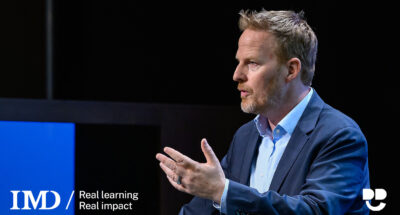
How do deans lead when the world turns upside down?
Global deans Catherine Duggan and Darren Dahl on leading through turbulence — and why optimism, not certainty, is the real power in today’s business education. ...

by Lars Häggström Published 8 August 2024 in Leadership • 9 min read
In January this year, Helena Helmersson stepped down as CEO of Swedish fashion brand H&M after four “very demanding” years navigating the company through the pandemic and geopolitical and macroeconomic challenges. In a media conference, she candidly admitted that she didn’t have enough “energy” to keep going in the role.
Helmersson is not alone in finding the top job increasingly draining. According to research from executive intelligence solutions provider Equilar, the median tenure among S&P 500 CEOs has decreased by 20% over the past decade, dropping from six years in 2013 to 4.8 years in 2022.
A rapidly changing business environment, an unprecedented pace of technological change, and growing pressure from consumers and shareholders to take accountability for a range of problems, from climate change to DE&I, are all taking a toll.
It’s perhaps unsurprising then that a growing number of CEOs are throwing in the towel after a shorter period. Yet continuity at the top and a long-term vision are vital if organizations are not only to succeed financially but also create societal value, as so many organizations aspire for and rightly should. Is it, therefore, time to rethink the long-held belief that one charismatic and visionary person should lead a company? And if so, what alternatives are there?

One model that is gaining popularity across companies operating in sectors as diverse as apparel, entertainment, and banking is the idea of co-chief executives. Especially in an age where organizations are expected to perform and transform at the same time, this model allows two leaders with complementary skill sets to work together. Prominent examples include Greg Peters, a data-driven tech leader, and Ted Sarandos, who has deep knowledge of the Hollywood entertainment industry, co-run Netflix, and Marc Maurer and Martin Hoffman at Swiss sportswear group On Running.
The advantages of having two brains over one are obvious. Given the multitude of challenges and priorities facing CEOs today, it is perhaps naïve to think that one person could realistically spot all the problems and opportunities. Having two people brings a diversity of experience and perspective, as well as an opportunity to clearly divide roles and responsibilities according to each person’s strengths. One person, for example, could focus on transforming the business for the future while the other deals with the day-to-day exploitation of the existing operations. In addition, some firms have a more external-facing CEO who deals with stakeholder management, while the other is more internally focused.
If you have two people shouldering the burden, it also means there will be more opportunities for rest, which is vital to maintaining top performance over the long run. In Sweden, the Football Association appointed two managers, Lars Lagerbäck and Tommy Söderberg, for its national soccer team, in 2001. Initially, there was some skepticism; players wanted to know who they should complain to if they weren’t picked for the side. Yet both managers stipulated it as a requirement of taking the job. They loved the sport, but they didn’t want to be consumed by the pressure and responsibility of doing it alone.
Establishing a co-CEO structure might also broaden the pool of applicants. Research shows that women are 16% less likely to apply for a job after viewing it than men because they tend to hold back if they don’t meet all the criteria. From my own personal hiring experience, women tend to be more candid about their lack of experience, making it easier to default to the excuse that they don’t tick all the boxes. But if the requirements change so that we no longer expect one person to realistically have the skills and experience to fulfill the entire scope of the role, it might become a more appealing prospect for a broader pool of candidates. This could foster an environment where applicants are less driven by ego and status, drawn instead to the opportunity of achieving great things while at the same time upholding a harmonious work-life balance.
Given the need to set aside ego, the model tends to work well at organizations, such as NGOs, where there is a strong sense of purpose and mission.
Given the need to set aside ego, the model tends to work well at organizations, such as NGOs, where there is a strong sense of purpose and mission. A case in point is Belu, a British drinks business that spends its net profits on reducing carbon emissions, implementing circular business models, and bringing clean water to the world.
Natalie Campbell, who became CEO just before the start of the pandemic, decided to split the top job with another colleague six months into her tenure. “I’ve always believed that if you lead a company, you should experiment and you should try things that mean you can be a vanguard in how you operate,” Campbell told the Financial Times.
The model works for the pair because they have clearly defined roles and responsibilities and spent a lot of time being vulnerable about their strengths and weaknesses at the start of the co-CEO relationship, explained Campbell.
There also needs to be a common desire to commit to a partnership through the ups and downs. As Marc Maurer, co-CEO of On, told my colleague Alyson Meister: “My role is to make Martin successful, and his role is to make me successful,” he said, referring to his co-CEO. “This allows us to care for each other and creates space for us both to perform at our best. It’s a lot of talking. It’s a relationship.”
To avoid cracks seeping into the relationship, both co-CEOs must stand united behind a decision once it’s been made, even if they were at loggerheads behind the scenes, says Maurer. “We don’t always agree, but rather than being angry or whatever, you have the tough discussions – but we do that with a lot of respect.”
Maurer often calls On “a partnership of five” since the three founders are still involved in the company. Maurer focuses on operations, sales, and marketing, while Hoffman is responsible for finance. The three founders, in turn, focus on product development. The company has consequently expanded from a startup to a Nasdaq-listed firm with a shared leadership model.
The model starts to fall apart as soon as there is any kind of power imbalance.
Often, there might not officially be two CEOs, but there will be two leaders who operate as if they are co-CEOs, dividing up responsibilities according to their complementary strengths. This was the case at Eli Lily when the US pharmaceutical company launched a new set of medicines for the central nervous system. The CEO’s time was spent dealing with external stakeholders such as regulatory authorities, governments, and payors, while the COO focused on running the company, even leading the executive committee meetings. At many organizations, there may be a leader who handles the pressing need to perform in the core business while another explores new opportunities.
The model starts to fall apart as soon as there is any kind of power imbalance. In some instances, a founder of a tech startup may hire a co-CEO to focus on the day-to-day running of the business. Yet this approach runs into trouble when the founder still wants to call all the shorts and struggles to let go.
Furthermore, in times of crisis the workforce and stakeholders still tend to gravitate toward one single leader. How do both co-CEOs handle communication in these situations? It’s important that they get equal airtime and present a unified front to avoid confusion and the emergence of tribes throughout the organization.
Just as challenging is deciding with whom the buck stops. Do both co-CEOs have equal accountability? If the board wants to hold someone to account, who do they fire? In these cases, it can be particularly challenging if certain board members favor one co-CEO over the other. In addition, there is often an unchartered course for how to end the partnership if one co-CEO wants out.
There also needs to be clarity around roles and responsibilities. Some duos will want to have this clearly written down in a charter, whereas other pairings may prefer to “go with the flow” depending on their relationship.
For the co-CEO model to truly take off, there also needs to be a mindset shift.
It’s clear that the ever-expanding complexity and scope of the CEO role are making it a less attractive proposition for many people. Yet the co-CEO arrangement is just one solution and not always guaranteed to succeed, as prominent failures at software company SAP and food chain Chipotle have shown.
Many CEOs are already handing more power over to members of their top management team without them having the formal co-CEO title. In many firms, for example, CEOs work closely with their COOs, allowing the latter to run the executive meetings and deal with internal challenges while they handle the external-facing work.
A move to flatter organizations where power is distributed among business units, and geographies can also help reduce the burden. A prime example is the Swedish industrial group Atlas Copco, which has only had 13 CEOs throughout its 151-year history. One of the reasons is their decentralized structure, which hands power to leaders throughout the organization, increasing the company’s agility and reducing the pressure on one person. Because of this setup, when the company does (infrequently) change CEO, it becomes less of a period of rupture and uncertainty.
For the co-CEO model to truly take off, there also needs to be a mindset shift. Many boards are comprised of former CEOs who might be confused as to why someone wants to share power or are suspicious of a person who admits they can’t do it alone – as they did. To overcome this, there might need to be “bottom-up” momentum where qualified applicants make their pitch for a co-CEO structure, as was the case with the head coaches of the Swedish soccer team.
Even if the board doesn’t consider the co-CEO model an option, asking the incoming CEO questions during the selection process can be helpful, such as: How will you make up for your lack of experience or expertise in these areas? And how will you make sure that you can sustain your leadership over time?
This sows the seeds for thinking about how to balance a person’s strengths and weaknesses, whether this involves building a close-knit top management team with complementary skills or a deputy who can step in when the person needs a break.
Only by asking these questions will we be able to move the future of leadership in a direction where we have a diverse pool of CEOs who are mentally and physically equipped to thrive in their roles.

Senior Adviser, IMD Business School
Lars Häggström is Senior Adviser at IMD and a former CHRO at Stora Enso, Nordea and Gambro.

19 May 2025 • by David Bach, Felix Zeltner in Leadership
Global deans Catherine Duggan and Darren Dahl on leading through turbulence — and why optimism, not certainty, is the real power in today’s business education. ...

19 May 2025 • by Peter Voser in Leadership
Board members have a central role to play in helping organizations steer a safe path in a polarized and skeptical world....
 Audio available
Audio available
16 May 2025 • by Merete Wedell-Wedellsborg in Leadership
Our new ‘normal’ turned out to be grimmer than many anticipated. Ask yourself these seven questions to find out if you and your team are fit to face the rocky road ahead....

13 May 2025 • by Mark J. Greeven, Sophie Liu, Wei Wei in Leadership
How CR Beer, the brewer of Snow beer and the exclusive Chinese partner of Heineken, redefined its legacy by shifting from mass‑market volume to premium innovation and Baijiu diversification under the bold...
Explore first person business intelligence from top minds curated for a global executive audience